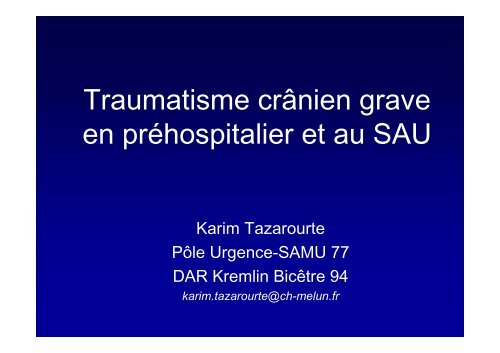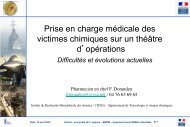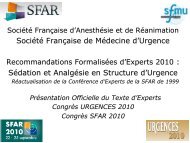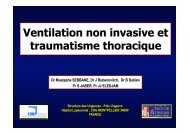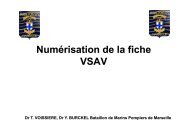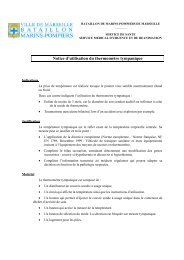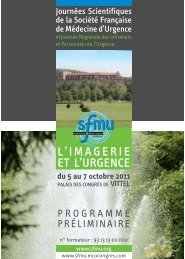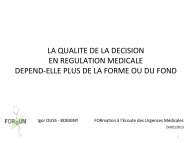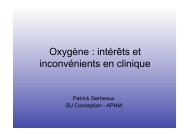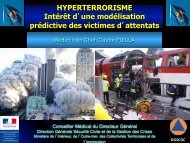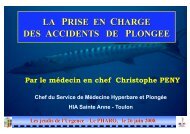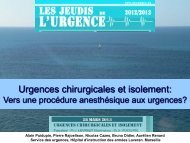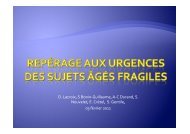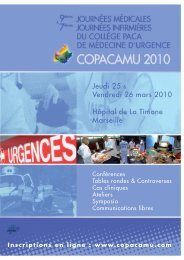traumatisme cranien grave - SMUR BMPM
traumatisme cranien grave - SMUR BMPM
traumatisme cranien grave - SMUR BMPM
Create successful ePaper yourself
Turn your PDF publications into a flip-book with our unique Google optimized e-Paper software.
Traumatisme crânien <strong>grave</strong>en préhospitalier et au SAUKarim TazarourtePôle Urgence-SAMU 77DAR Kremlin Bicêtre 94karim.tazarourte@ch-melun.fr
Problème de santé publiqueBase NHDS2 107 955 patients hospitalisés pour traumaDépenses estimées : 11,4 milliards $Lésion principaleTraumatismes crâniensEnsemble des patientsTr. Crâniens AIS ≥ 3Traumatismes rachidiensVolume14 %4 %1 %Coûtrelatif20 %15 %3 %MacKenzie EJ et al. J Trauma 1990;30:1096-1101
Importance de la prévention17 TCG/100 000 h (1996) vs 24 /100 000 h(1986) ;Age moyen 44 ans– Mortalité 5.2 / 100 000 h– 2 groupes : [15-30 ans –AVP], [> 60 ans- Chutes]IDF 3 TCG / 100 000 h (2007)44 % [15-35] ; 26 % > 55 ansMasson J Trauma 2001;51:481-89
Mortalitéannuelle(Millions)181614121086420Projection de la mortalité mondialeannuelle par pathologieMaterno-fœtale Tabac Traumatisme19902020Murray CJ Lancet 1997;349:1498-504
Un <strong>traumatisme</strong>,…DestraumatisésEnquête SAMU de France– 333 traumatisés <strong>grave</strong>s– 89 % AVP– 60 % TC– 8% choc hémorragiqueVincent G JEUR 2003Seattle– 423 traumatisés <strong>grave</strong>s– 32% <strong>traumatisme</strong>spénétrants– 47% TC– 45% Thorax-abdomenArreola-Risa C J Trauma 1995
70%lésions associées au TC lors d'un<strong>traumatisme</strong> <strong>grave</strong>60%50%40%30%20%extrémitésthoraxabdomenfacerachis cervical10%0%Regel J Trauma 1995Hills J Trauma 1993
Importance des premières heures• 90% de lésions ischémiques : PPC = PAM-PICGraham J Neurol Neurosurg 1989• Bas DSC chez 30 à 50% des patientsBouma J Neurosurg 1992• Hypotension préhospitalière : mortalité x 2,5Chesnut J Trauma 1993• Influence hypotension, hypoxie, hyperthermieJones J Neurosurg Anesth 1994
Autorégulation cérébrale et<strong>traumatisme</strong> crânienChan KH Neurosurg 1993 Bouma J Neurosurg 1992DSCPPC = PAM - PIC50 60 150PPC = RVC x DSCPPC(mmHg)
Courbe pression / volume intra-crânienPIC (mmHg)150100compliance basse50compliance élevée01 2 3 4 5 6 7 8Volume (ml)
H, 32 ans, AVP à 16h 15,17hGCS=1519hGCS=7
DSC(% valeurcontrôle)+200++PaCO 2150+++100++PaO 2+50++0 25 50 75 100 125 150 200 mmHgInfluence de la PaCO 2 et de la PaO 2 sur le DSCN Engrand MAPAR 2003
PICPIC38,4Température37,135,8Température34,5PETCO2ET CO2
Les R.P.C.Ann Fr Anesth Réanim 1999Bullock J Neurotrauma 2007• Intubation à partir d’un G.C.S. ≤ 8• Induction anesthésique à séquence rapide etsédation continue• PAS ≥ 90 mmHg• SaO2 ≥ 90 %• Normocapnie• Utilisation de solutés isotoniques• Utilisation du mannitol si HTIC (mydriase)• Orientation hospitalière• Monitorage multimodal
Etat des lieux en 1998Rouxel, Tazarourte, Viguè Ann Fr Anesth Réanim 2004Variables Oui NonInt / Vent 202(98%) 5 (2%)Sédation 168(81%) 39 (19%)Mannitol 0 78 (100%)PAS >90 mmHg 151(73%) 56 (27%)SaO 2 > 90 % 183(88%) 24 (12%)PaO 2 > 60 mmHg 171(83%) 36 (17%)Normocapnie 51(25%) Hypocapnie: 83(40%)Hypercapnie: 73 (35%)36.5
REAL World in France (Paris)for the management of severe TBI• n = 304 Prognostic severe TBI Factors in 4 yearsMortality (6 months) 45 %(30% in the emergency room)MAP MICUGCS at hospital• Good outcome 43 %Mydriasis at hospital• n= 32 (11%) neurosurgical• Time to arrival at hospital 3 h ± 1hRouxel, Tazarourte, Viguè Ann Fr Anesth Réanim 2004
Evaluation initiale du traumatisécrânien• Etat de conscience : GCS– Méthode de cotation Teasdale Lancet 1974– Reproductible Menegazzi J Trauma 1993– Valeur discriminative Prasad J Clin Epidemiol 1996
The Predictive Value of Field versus Arrival GlasgowComa Scale Score and TRISS calculations inModerate-to-Severe Traumatic Brain Injury(10, 396 patients)Davis DP J Trauma 2006;60:985-90•fGCS 11,4 vs aGCS 11,5 : r² = 0,67, 95% CI 0,66-0,69•Motor score : optimized threshold value for mortality = 3
Les GCS intermédiairesGCS initial vs survie (%)GCS moteur et survie (%)100%80%60%40%20%100%80%60%40%20%Survie (%)0%3 4 5 6 7 8 9 10 11 12 13 14 15GCS initialDavis DP J Trauma 20060%1 2 3 4 5 6GCS moteurUdekwu P J Trauma 2004;56:1084-89Davis DP J Trauma 2006;60:985-90
elation GCS initial et inhalation bronchique40%% inhalation bronchique35%30%25%20%15%10%5%inhalation bronchique0%3 5 7 9 11 13 15GCS initialAdnet F Lancet 1996
GCS 10Cotation erronée pour 35 %médecinsLenfant F Ann Fr Anesth Réanim 1997Rebillard L, Tazarourte K Urgence 2006
Previous etomidateNo previous etomidateCortisol (ųg/ml) 27,2 * 35,5Cohan P Crit Care Med 2005;33:2358-66Payen JF ICM 2008
Succinylcholine et inductionen séquence rapideJeevrenda Martyn Anesthesiology 2006; 104:158-69• Installation rapide (≤ 1 min) et durée courte (≤ 5min)• Pré-curarisation (« dose de défasciculation ») inutile• Contre-indications rares (allergie connue etlésions motoneurones)• Utilisation recommandée même si HTIC outrauma musculaire (hyperkaliémie modérée)• 1 cas d’arrêt cardiaque attribué à unehyperkaliémie/610 utilisations
Les avantages de l’ISRAdnet F Anesthesiology 2001Combes X Acad Emerg Med 200660%% intubation50%40%30%Bloc opératoire n =365Préhospitalier n=311Préhosp. avec protocole n =141220%10%0%0 1 2 3 4 5 6 7 >8FacileIDSDifficile
Relation between GCS andcough reflexMoulton C Lancet 1994;343:1261-2
Guidelines for initial management of spinal injuryBritish Trauma Society 2002
The effect on laryngoscopy of different cervical spineimmobilisation techniquesHeath KJ Anaesthesia 1994;49:843-45100%90%80%70%60%50%40%30%20%10%0%1 2 3 4collier cervicalstabilisation manuelleposition standartGrade de Cormack
Intubation sans minervebénéfice pour le patient ou pour l ’opérateur ?Gerling MC Ann Emerg Med 2000;36:293-300 (cadavres C5)%1210864stabilisation manuellecollier cervical20sub luxation distraction rotation
Cervical Spine Motion with directLaryngoscopy and oro-tracheal intubationSawin PD Anesthesiology 1996;85:26-36 (sujets sains)765C0-C1Extension432C1-C2C2-C3C4-C51Flexion0Position de base Préinsertion Insertion Postintubation-1
Manœuvre de sellickLancet 1960Ann Emerg Med 2007gêne la visualisation ?Oui : Haslam N Anaesthesia 2005Levitan Ann Emerg Med 2006Dhonneur BJA 2007Non : Turgeon AT Anesthesiology 2005C 6Qualité de réalisationKopka A Eur J Emerg Med 2005
Acta Anesth Scand 2007Anesth Analg 2007½ vie du rocuroniumDanger
Effetshémodynamiquesdes morphiniquesMorgan Anaesthesia 2007
Bourgoin A Crit Care Med 2005
Les R.P.C.Ann Fr Anesth Réanim 1999Bullock J Neurotrauma 2007• Intubation à partir d’un G.C.S. ≤ 8• Induction anesthésique à séquence rapide etsédation continuePAS > 120 mmHg• PAS ≥ 90 mmHgFerdinande Intensive Care Med 1999• SaO2 ≥ 90 %• Normocapnie• Utilisation de solutés isotoniques• Utilisation du mannitol si HTIC (mydriase)• Orientation hospitalière
Pronostic et PAS(n=265, 1994-1998)• Variables Bon Mauvais p• PAS Avant 126±29 107±57 0,0001• PAS Après 129±25 110±40 0,0001• SaO 2 Avant 94±11 73±39 0,0001• SaO 2 Après 97±09 97±13 NSRouxel, Tazarourte, Viguè Ann Fr Anesth Réanim 2004
Paramètres pendant le transportRouxel, Tazarourte, Viguè AFAR 2004120100Cas détectés dès la prise en charge SAMUCas réfractaires jusqu’à l’arrivéeTous sédatésPas de cathécholaminesPas de pression invasive80Nouveaux cas pendant le transportNombre de patients6040200PAS
Early modifiable factors associatedwith fatal outcome in patients withsevere traumatic brain injuryHenzler D Crit Care Med 2007• S or NS ; same GCS (4,6 ± 3,1), Age (37,8 ±21,3),ISS (31,4 ± 8,6), TRISS (51,4 ± 21,2), and SBP atscene (111 ± 40 mmHg)4 HLowestSBPLowestMAPLowest T°PTT (sec)pS116 ±2280 ± 1536,2 ±1,543 ±39N=37NS105 ±24*71 ±16*35,1 ± 1,4*57 ± 49*N=37S = Survivor, NS = No Survivor
Prise en charge hémodynamique• Introduction précoce de Noradrénaline– Après et sous remplissage vasculaire (colloïdes)Poloujadoff MP Anesthesiology 2007 (rats)– Compenser les effets vasoplégiques de la sédation continueet/ou de la lésion médullaire• Ephédrine 3 – 6 mg IVD si hypotension aprèsinduction anesthésique à séquence rapide• Monitorage de la pression artérielle– Non invasif par méthode oscillométrique– Invasif selon l’expertise du médecin et les délais detransport Journées scientifiques SFMU Nantes 2007
PAM 8O mmHg suffisant ?Vigué Int Care Med 1999n = 27 Avant Après p*PAM (mmHg) 79 ± 9 103 ± 10 < 0,001PIC (mmHg) 25 ± 11 25 ± 14 NSPPC (mmHg) 53 ± 15 78 ± 10 < 0,001SvjO 2 (%) 56 ± 12 72 ± 7 < 0,001
Vigué Int Care Med 199910080PAM 79 ± 9 mmHgPAM 100SjvO 2(%)60402020 40 60 80 100CPP (mmHg)
De la rue à l’hôpital7 heures !!!1994 - 98195’15’ 70’ 110’De l’hôpital à la PICPIC210’60’ 90’60’Vigué et al Ann Fr Anesth Réanim 2004
Dopplers anormaux( n=11 )Dopplers normaux( n=13 )T 0 T 1 T 0T 1AgeGCSISSLésions TDMDélai arrivée (min)Délai (min)33±12525III202±13916±8219±96 min35±127**20III142±6420±12262±123 minDTC anormaux11200PAM (mmHg)DTC (cm/s)VmVdIPPIC (mmHg)PPC (mmhg)PPC
De la rue à l’hôpital195’15’ 70’ 110’A l’hôpitalDTCPIC210’60’ 90’60’
DTC en préhospitalier• n = 19 patients inclus (40 ± 26 ans)– GCS 6 ± 4, PAM 87 ± 24 mmHg (pas de différence dans lesgroupes DTC nle et DTC anle)• Délai entre <strong>traumatisme</strong> et DTC initial = 75 ± 50 min– un échec de mesure de DTC (femme de 88 ans)• Vd ≤ 20 cm/s et IP > 1,4 pour 9 patients (dont 4 patientsavec mydriase aréactive)– Mannitol 20 % 250 ml répété une fois si besoin
DTC pré-hospitalier3,532,52Vd1,56010,50IPIP 1 IP 25040302010Tazarourte, ICM, soumis0Vd 1 Vd 2
Le Doppler transcrânien
SystoleMoyennecalculéeDiastoleDébit = vélocité x diamètre del’artèreIP=Vs-Vd/VmIR (Pourcelot) = Vs – Vd / Vs
La gravité de la présence d’une mydriaseRouxel, Tazarourte, Viguè Ann Fr Anesth Réanim 2004Tien HC J Trauma 2006;60:274-8FX Duchateau Ann Fr Anesth Réanim 2004N908070605040302010014 13 12 11 10 9 8 7 6 5 4 3 3M+GCSDécédésVivants
Les urgentistes etl’osmothérapieRebillard, Tazarourte Urgence 2006 [R]100%Moyens à disposition (2005)Connaissance de l'usage dumannitol90%80%70%60%50%40%30%20%10%0%Mannitol 20%SSH100%90%62% 80% ne l’ont jamais utilisé70%60%50%40%30%20%10%0%2000 2005450 médecins interrogés à deux périodes de 5 ans d’intervalle
L’importance de l’osmothérapie• Phénomènes osmotiques nécessitant le respect BHE• Diminution PIC et restauration PPC• effet prédominant du coté sain Lescot CCM 2006• Mannitol– effet "rebond" (expérimental)– surtout variations osmotiques, diurèse osmotique et sescomplications : Hypovolémie• SSH White H Anesth Analg 2006
Crit Care Med 2005
• 229 patients avec TC (CGS ≤ 8) isolé ethypotension (PAS < 100 mmHg)• 2 groupes randomisés :– Ringer 250 ml– SSH 250 ml à 7,5%• NS sur le pronostic6050403020Cooper, JAMA 2004100GOS 1-2 GOS 3 GOS 4-5
Mydriase aréactive = osmothérapieNiveau 2 Guidelines 2007• Mannitol 20 %250 ml à renouveler une fois si mydriasepersistante ; expansion volémique obligatoire• Sérum salé hypertonique 7,5 %125 ml ; pas de polyurie
J Trauma 2007Davis PCrit Care Med 2006;34:1202-208
An national evaluation of the effectof trauma-center care on mortalityMacKenzie EJ N Eng J Med 2006; 354:366-7845,00%40,00%35,00%*Mortality30,00%25,00%20,00%15,00%10,00%5,00%0,00%*< 55 ans > 55 ans max AIS 3 max AIS 4 max AIS 5-6TC 5,90% 12,30% 2,30% 8,30% 30,20%Non TC 9% 13,10% 1,60% 11,80% 43,20%
80,00%*J Trauma 2006;60:1250-5670,00%60,00%50,00%40,00%*Dead30,00%20,00%20,70%25,60%Alive10,00%0,00%DirectIndirect
Survivants100%90%80%70%60%50%40%30%20%10%0%Intérêt des RPCBulger EM et col Crit Care Med 2002;30:1870-76Fakhry SM J Trauma 2004;56:492-500JO-J7 J 7-J14 J14-J21 J21-28 J28-J35RPCNon RPC
Intérêt d’une médicalisationpréhospitalièreAnglo-saxon (mortalité prédite par méthode TRISS) vs France (mortalitéobservée) n = 600 traumatisésISS ISS ISS TCG3-25 26-40 41-75n 469 88 51 115Mortalité 2% 37% 81% 60%préditeMortalité 2% 28% 80% 48%observéeScore Z -0.44 -2.09 - 0.15 - 3.57p ns
Importance du monitoragemultimodal Gupta BJA 200725%Bulger, CCM, 2002
TCG en Ile de France 2007• 542 patients (22 mois : 2005-07)– 63 % polytraumatisés,• 14 % d’état de choc hémorragique– 12 % neurochirurgicaux urgents– 114 ± 38 minutes de temps de prise en charge• Appel SAMU-Arrivée <strong>SMUR</strong> : 30 ± 28 min• Arrivée <strong>SMUR</strong>- Bilan <strong>SMUR</strong> : 32 ± 15 min• Temps notification de destination : 14 ± 10 min• Temps notification – hôpital : 40 ± 25 min– 30 % des patients admis en centres nonspécialisés– Mortalité J 28 : 44 % (35 % de décès J 1)
TCG en IdF• 25 % PAS < 90 mmHg à l’admission– 15 % des patients sans état de choc associé• Usage des cathécolamines– 2 patients / 3 sans choc• 25 % des patients avec une mydriasearéactive uni ou bi latérale– Osmothérapie pour 58 % des patients
Analyse des décès précocesVivantsDécès 48 hpAge40 ± 1948 ± 22*ISS3142*PAS admission (mmHg)123 ± 23115 ±41*Episodes d’hypoTA0,180, 83*Hypoxémie initiale (%)17 %35%*Mydriase bilatéralearéactive (nb patient)1855*ETCO2 admission35 ± 729 ± 8*
Accueil déchocage• Lésions associéesStein, Neurosurgery 1993• Troubles de l’hémostase et anémie– Règles strictes de transfusion :Ht>30% ; Hb>10 ; TP>60 ; Plaq>100000• Glycémie• HyperthermieCrit Care Med 2006Réversion si AVK
ConclusionLe temps d’arrivée à l’hôpitalL’organisation de l’arrivéeLes décès des premières heures (30%)Le respect des recommandationsUn monitorage adapté
1 gramme de traitement pendant les premièresheures vaut des Kilos de traitements enréanimation


